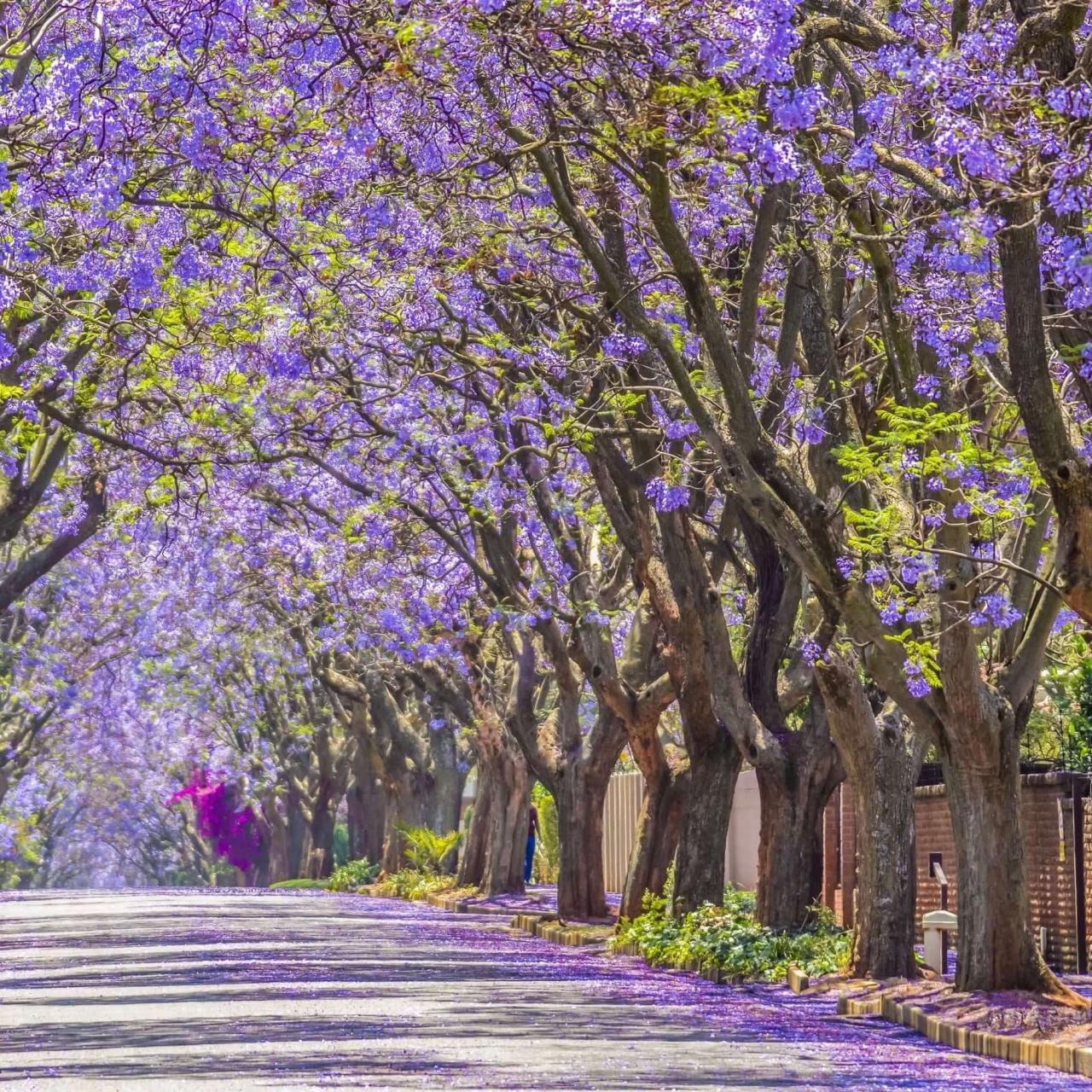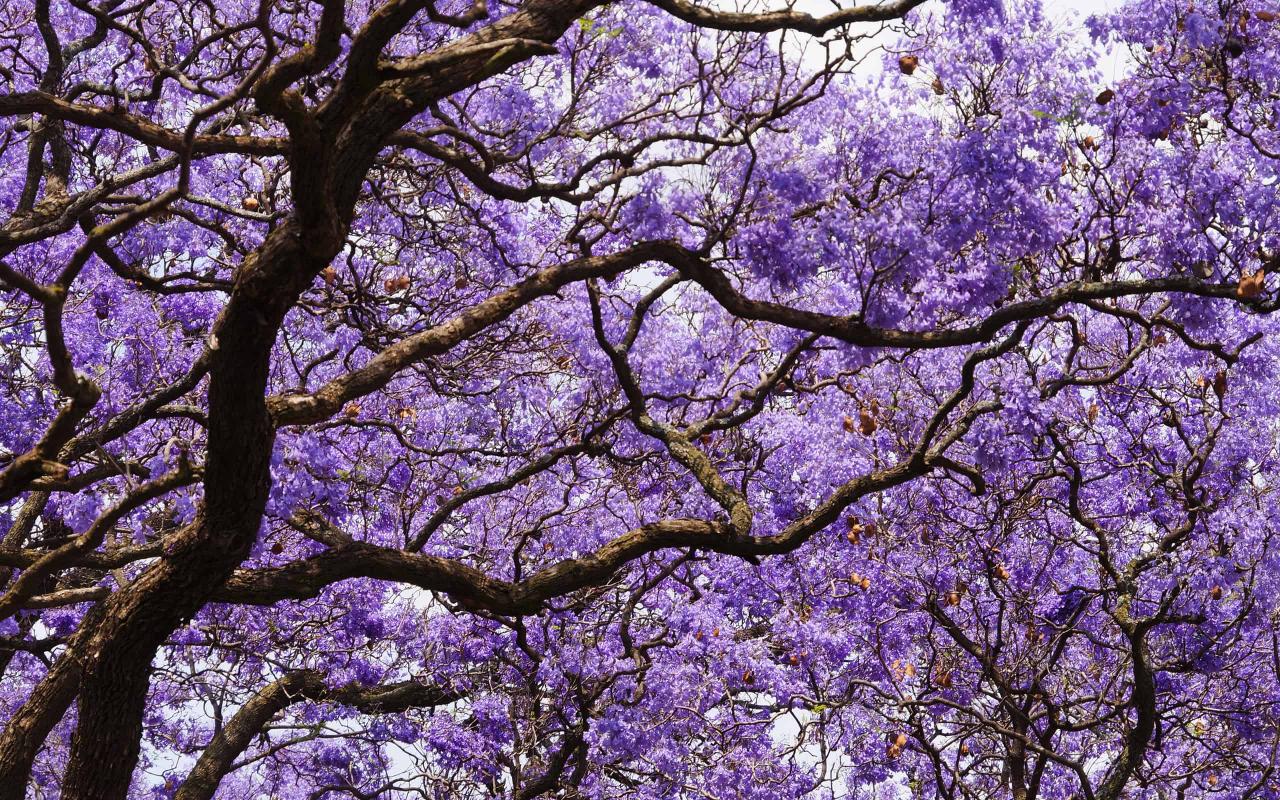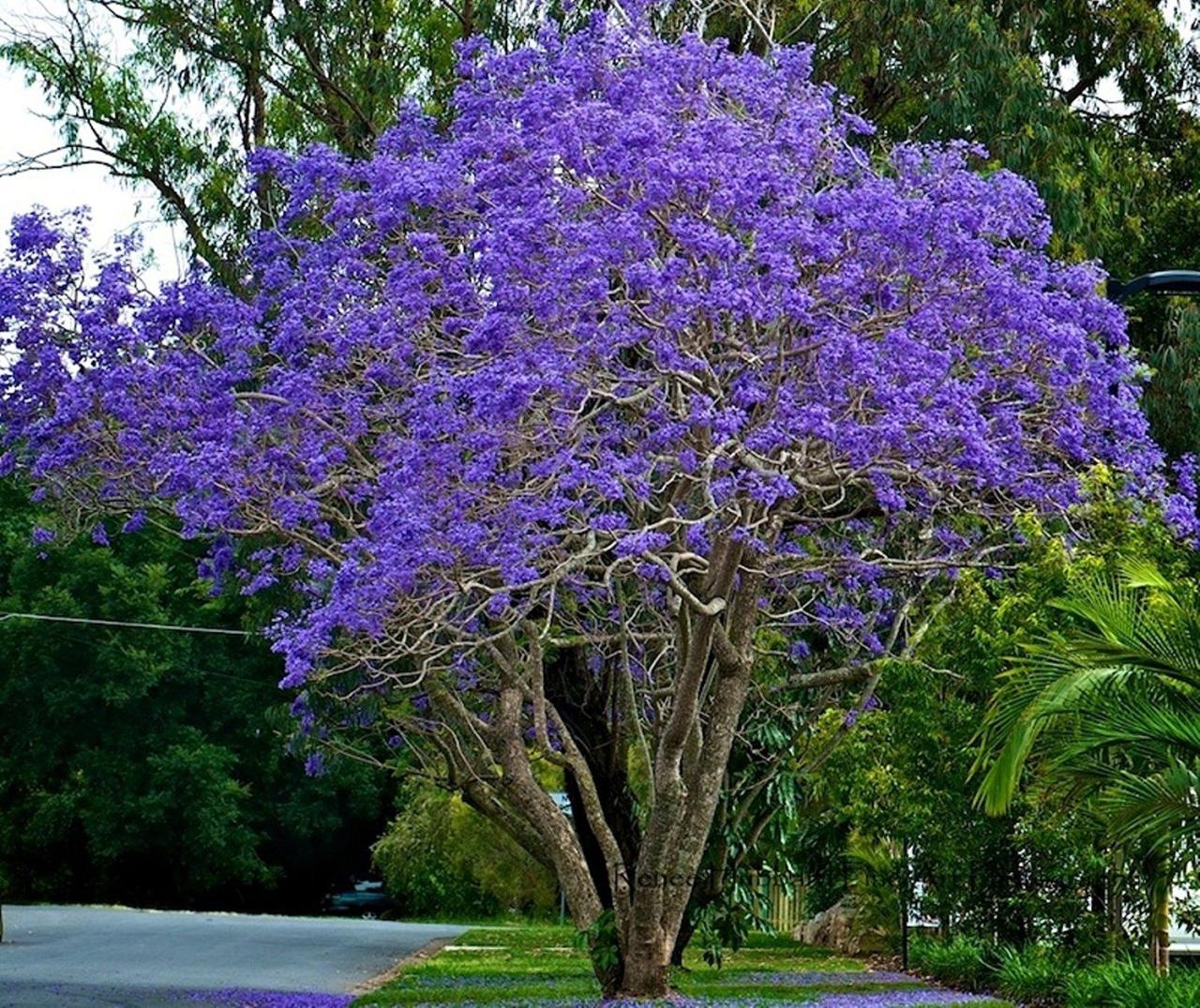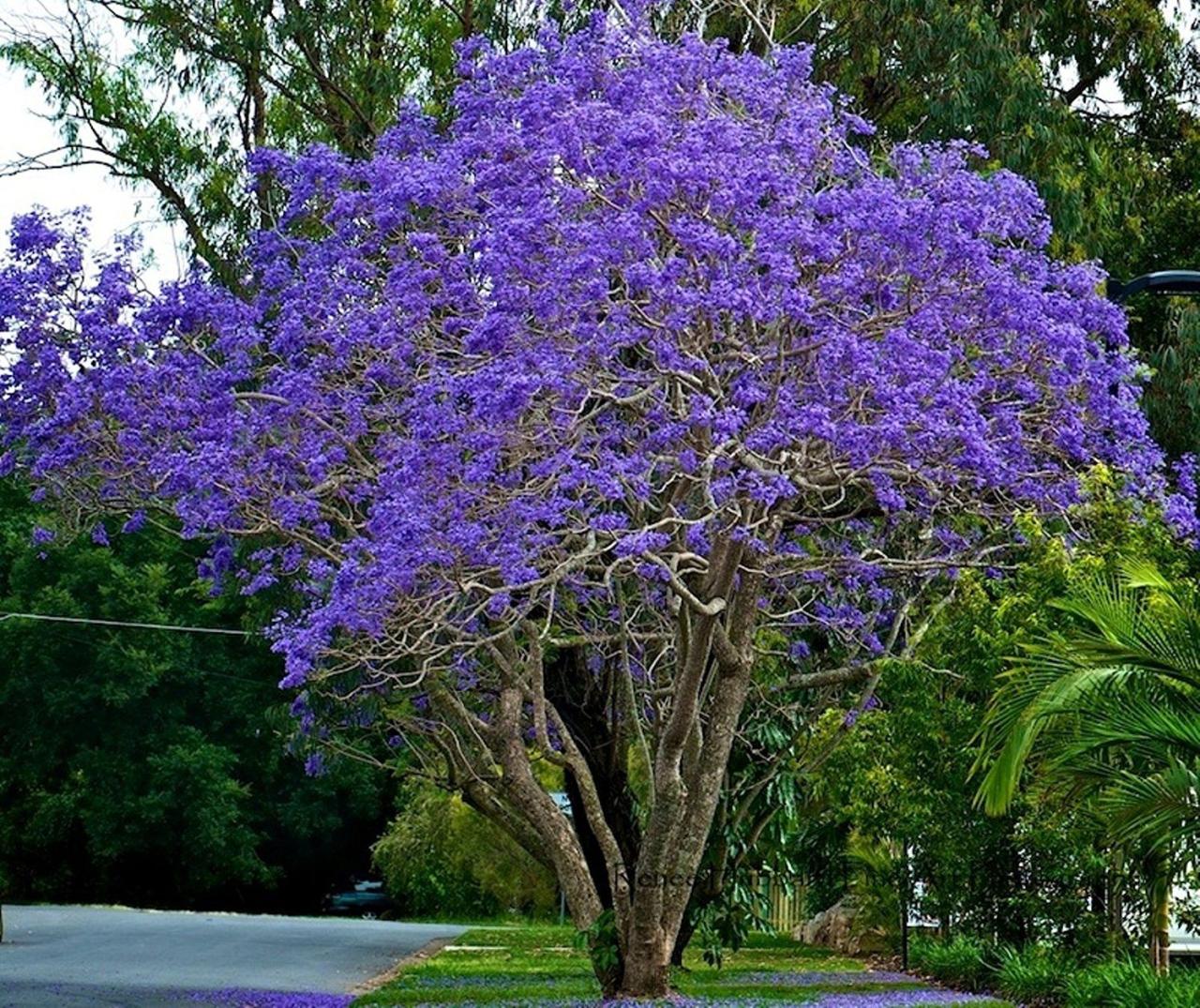How to Use Jacaranda Tree for a Vibrant and Elegant Outdoor Space: Essential Tips – The Jacaranda tree, with its breathtaking purple blooms and graceful silhouette, is a true gem for any landscape. Its presence transforms ordinary outdoor spaces into vibrant and elegant oases.
This guide will delve into the secrets of using Jacaranda trees to create captivating outdoor environments, exploring everything from planting and care to design inspiration and practical tips.
From its striking visual appeal to its cultural significance, the Jacaranda tree offers a unique blend of beauty and practicality. We’ll explore its growth habits, planting requirements, and care tips, ensuring you cultivate a healthy and thriving Jacaranda that will become the centerpiece of your outdoor haven.
The Allure of the Jacaranda Tree

The Jacaranda tree, with its captivating beauty and vibrant blooms, is a beloved addition to landscapes worldwide. Its unique characteristics, including its striking purple flowers, graceful form, and captivating fragrance, make it a highly sought-after choice for creating a vibrant and elegant outdoor space.
Jacaranda trees are known for their majestic presence and their ability to transform any garden into a breathtaking spectacle. Their cascading branches adorned with vibrant purple flowers create a mesmerizing display, adding a touch of magic and elegance to any outdoor setting.
Growth Habits of the Jacaranda Tree
Jacaranda trees are native to South America and thrive in warm climates. They are fast-growing trees that can reach heights of up to 60 feet, with a spreading canopy that can extend up to 50 feet. Their distinctive fern-like leaves provide a lush and tropical feel, while their stunning purple blooms create a breathtaking display during their flowering season.
The Jacaranda tree’s flowering season typically occurs in late spring and early summer, although the exact timing can vary depending on the climate and geographic location. During this time, the tree bursts into bloom, covering itself in a cascade of vibrant purple flowers that resemble delicate bells.
The flowers are known for their sweet fragrance, which adds another dimension to the tree’s allure.
Symbolism and Cultural Significance
The Jacaranda tree holds a special place in many cultures, symbolizing beauty, prosperity, and good luck. In South Africa, where the tree is particularly prevalent, the Jacaranda season is celebrated with festivals and events, marking the arrival of spring and the promise of new beginnings.
The tree’s vibrant purple flowers are often associated with royalty and elegance, adding a touch of sophistication to any landscape. Its association with good luck and prosperity makes it a popular choice for planting near homes and businesses, where it is believed to bring blessings and success.
Planting and Care for a Thriving Jacaranda: How To Use Jacaranda Tree For A Vibrant And Elegant Outdoor Space: Essential Tips

Jacaranda trees, with their captivating purple blooms, are a breathtaking addition to any outdoor space. However, cultivating a healthy and vibrant Jacaranda requires careful consideration of its specific needs. Understanding the optimal conditions for planting and care is crucial for ensuring the tree thrives and rewards you with its stunning beauty.
Soil Type and Sunlight Exposure
The Jacaranda tree thrives in well-drained soil that is rich in organic matter. It prefers a slightly acidic pH range, ideally between 6.0 and 6.5. Sandy loam soils are generally well-suited, providing excellent drainage and aeration. Avoid planting in heavy clay soils, which can lead to root rot due to poor drainage.
Sunlight is another essential factor in the growth and flowering of Jacaranda trees. They require at least six hours of direct sunlight daily. This ensures optimal photosynthesis, allowing the tree to produce abundant foliage and flowers. Planting in a location that receives full sun exposure will contribute significantly to the tree’s overall health and vibrancy.
Watering Requirements, How to Use Jacaranda Tree for a Vibrant and Elegant Outdoor Space: Essential Tips
Jacaranda trees are relatively drought-tolerant once established. However, during the first few years after planting, regular watering is essential to promote healthy root development. Watering deeply and infrequently is recommended, allowing the soil to dry slightly between waterings. This encourages the roots to grow deeper, increasing the tree’s resilience to drought conditions.
During periods of extended drought or high temperatures, supplemental watering may be necessary. Observe the soil moisture levels and water when the top few inches of soil feel dry.
Pruning Techniques
Pruning is essential for maintaining the Jacaranda tree’s shape, promoting healthy growth, and preventing disease. The best time to prune is during the dormant season, typically in late winter or early spring before new growth emerges.
Types of Pruning
* Shape Pruning:This involves removing branches that are growing in undesirable directions or are crossing over, creating a more balanced and aesthetically pleasing shape. – Renewal Pruning:This method focuses on removing older, diseased, or dead branches to encourage new growth and maintain the tree’s vigor.
– Thinning Pruning:This technique involves selectively removing branches to improve air circulation and sunlight penetration within the canopy, reducing the risk of disease and insect infestations.
Potential Challenges and Pests
While Jacaranda trees are generally hardy, they can be susceptible to certain challenges and pests.
Common Challenges
* Root Rot:This condition occurs when the soil is poorly drained, leading to excessive moisture around the roots. Symptoms include yellowing leaves, wilting, and stunted growth. – Leaf Spot Diseases:These fungal diseases manifest as brown or black spots on the leaves, which can eventually lead to leaf drop.
Pest Infestations
* Scale Insects:These tiny insects suck sap from the tree, causing damage to the leaves and branches. – Mealybugs:These pests secrete a white, waxy substance that can coat the leaves and stems, inhibiting growth.
Preventive Measures
* Proper Drainage:Ensure the soil drains well to prevent root rot. – Regular Inspection:Monitor the tree regularly for signs of disease or pest infestations. – Organic Solutions:Use organic pesticides and fungicides to control pests and diseases, minimizing the impact on beneficial insects and the environment.
Designing with Jacarandas for Visual Impact
The Jacaranda tree’s vibrant purple blooms and graceful, spreading canopy make it an exceptional choice for adding a touch of elegance and drama to any outdoor space. Its unique characteristics can be strategically used to create visually captivating landscapes, transforming gardens, parks, and even streetscapes into breathtaking havens.
Using Jacarandas as Focal Points
A Jacaranda tree can serve as a magnificent focal point in a landscape design, drawing attention and adding a sense of grandeur. Here are some examples of how to strategically place a Jacaranda to maximize its visual impact:
- At the End of a Path or Driveway:Planting a Jacaranda at the end of a pathway or driveway creates a dramatic welcome, inviting visitors to pause and admire its beauty. The tree’s cascading blooms provide a striking visual backdrop, enhancing the sense of arrival.
- In the Center of a Lawn:Positioning a Jacaranda in the center of a lawn creates a focal point that draws the eye from all angles. The tree’s spreading canopy and vibrant blooms act as a natural centerpiece, adding a touch of sophistication to the landscape.
- Near a Water Feature:Combining a Jacaranda with a water feature, such as a pond or fountain, creates a serene and enchanting atmosphere. The purple blooms and the gentle sound of water create a harmonious blend of sight and sound, transforming the space into a tranquil oasis.
Creating Dramatic Effects with Cascading Blooms
The Jacaranda’s cascading purple blooms create a dramatic effect that can transform an ordinary outdoor space into an extraordinary one. The tree’s blooms are a breathtaking sight, resembling a cascade of purple confetti, adding a touch of whimsy and elegance to the landscape.
“The Jacaranda’s blooms are like a cascade of purple confetti, adding a touch of whimsy and elegance to the landscape.”
Creating a vibrant and elegant outdoor space with a Jacaranda tree is a fantastic choice, as its stunning purple blooms bring a touch of tropical charm. To complement this natural beauty, consider adding culinary herbs to your landscape, such as the versatile perilla leaf, which is often used in Asian cuisine.
Learn more about cultivating and using this flavorful herb in our comprehensive guide: How to Grow and Use Perilla Leaf: Tips for a Flavorful and Healthy Herb. By incorporating herbs into your garden, you can enhance the sensory experience of your outdoor space, creating a haven for both aesthetics and culinary delight.
Complementing Jacarandas with Contrasting Colors and Textures
To enhance the visual impact of Jacarandas, consider using contrasting colors and textures in landscaping. The vibrant purple blooms of the Jacaranda provide a striking backdrop for plants with contrasting colors and textures, creating a visually dynamic and harmonious landscape.
- Contrasting Colors:Planting yellow, orange, or white flowering plants near a Jacaranda creates a visually stimulating contrast, enhancing the vibrancy of the purple blooms. Examples include sunflowers, marigolds, and white hydrangeas.
- Contrasting Textures:Incorporating plants with contrasting textures, such as ferns, grasses, or succulents, adds depth and dimension to the landscape, complementing the Jacaranda’s delicate blooms. The interplay of different textures creates a visually engaging and textural landscape.
Jacaranda Tree in Outdoor Living Spaces

The Jacaranda tree’s beauty extends beyond its visual appeal, offering a unique opportunity to create captivating outdoor living spaces. Its elegant canopy and vibrant blooms provide a natural framework for relaxation, entertainment, and a connection with nature.
Designing an Outdoor Seating Area with a Jacaranda Tree
A Jacaranda tree can serve as the centerpiece of a stunning outdoor seating area. Here’s a layout incorporating the tree’s natural beauty and creating a harmonious atmosphere:
- Placement:Position the seating area beneath the Jacaranda’s canopy, ensuring adequate shade during the hottest hours. This creates a natural haven for relaxation and provides a cool retreat from the sun.
- Furniture Arrangement:Choose furniture that complements the tree’s graceful silhouette. A circular or oval-shaped seating arrangement, such as a wrought iron patio set or a collection of wicker chairs, allows for easy conversation and a sense of intimacy. Consider incorporating a hammock or a swing for a touch of whimsy and relaxation.
- Lighting:Enhance the ambiance with soft lighting. String lights draped through the branches create a magical effect, especially at night. Lanterns placed strategically around the seating area add warmth and charm. Solar-powered lights are a sustainable and practical option, illuminating the space without the need for electrical wiring.
Outdoor Furniture Options that Complement the Jacaranda Aesthetic
A Jacaranda’s delicate blooms and graceful branches inspire a range of furniture styles. Consider these options for your outdoor space:
Furniture Style |
Description |
Jacaranda Harmony |
|---|---|---|
Wrought Iron |
Classic and elegant, often adorned with intricate designs. |
Complements the Jacaranda’s delicate beauty with its intricate patterns. |
Rattan or Wicker |
Natural materials create a warm and inviting atmosphere. |
Offers a relaxed and natural feel, reflecting the Jacaranda’s organic beauty. |
Teak Wood |
Durable and weather-resistant, with a rich, warm tone. |
Creates a sense of sophistication and complements the Jacaranda’s vibrant colors. |
Outdoor Fabrics |
Choose fabrics in soft pastels or vibrant hues that echo the Jacaranda’s blooms. |
Adds a touch of color and texture, enhancing the overall aesthetic. |
A Jacaranda-Shaded Patio: An Ambiance of Tranquility
Imagine a patio bathed in the dappled sunlight filtering through a Jacaranda’s canopy. The air is filled with the sweet scent of its blossoms, creating a calming and romantic atmosphere. The gentle rustle of leaves adds a soothing background melody.
The vibrant purple hues of the flowers paint the patio with splashes of color, creating a visual feast. This serene space is a perfect retreat for enjoying a cup of coffee, reading a book, or simply relaxing and soaking in the beauty of nature.
Incorporating Jacaranda into Your Outdoor Oasis
Transforming your outdoor space into a vibrant and elegant haven is made even more achievable with the Jacaranda tree. Its captivating beauty and versatility offer a myriad of possibilities for enhancing your garden or outdoor living area. This section delves into practical tips and creative ideas for seamlessly integrating the Jacaranda into your existing landscape.
Jacaranda Tree Placement and Integration
Strategic placement of the Jacaranda tree is paramount for maximizing its visual impact and ensuring its healthy growth. Consider the following tips when incorporating the tree into your outdoor oasis:
- Sunlight Requirements:Jacaranda trees thrive in full sun, requiring at least six hours of direct sunlight daily. Select a location that provides ample sunlight throughout the day. Avoid planting in areas with excessive shade, as this can hinder growth and flowering.
A Jacaranda tree’s vibrant blooms can instantly elevate your outdoor space, but remember that the right greenery can complement its beauty. Consider adding a touch of lushness with trailing ivy, which can be easily propagated and trained to cascade over fences or walls.
To learn more about propagating ivy and creating a beautiful green space, visit Create a Beautiful Green Space by Learning How to Propagate Ivy. This combination of vibrant Jacaranda blossoms and cascading ivy creates a visually captivating and elegant outdoor setting.
- Space Considerations:Jacaranda trees can grow quite large, with mature trees reaching heights of 40 to 60 feet. Ensure sufficient space is available to accommodate its mature size. Planting it near structures or other trees can lead to overcrowding and competition for resources.
- Soil Drainage:Jacaranda trees prefer well-drained soil. Avoid planting in areas with poor drainage, as this can lead to root rot and other problems. If your soil is prone to waterlogging, consider amending it with compost or other organic matter to improve drainage.
- Existing Landscape:Consider the existing landscape and the overall design aesthetic when choosing a location for your Jacaranda tree. Its vibrant purple blooms can create a striking contrast against a backdrop of green foliage or complement existing flower beds.
Creative Uses for Jacaranda Blossoms
Beyond its visual appeal, the Jacaranda tree offers a wealth of opportunities for creative expression. Its vibrant purple blossoms can be incorporated into various crafts and decorative elements:
- Floral Arrangements:Jacaranda blossoms add a touch of elegance and whimsy to floral arrangements. Their delicate petals and vibrant color create a stunning centerpiece for any occasion.
- Dried Flower Crafts:Jacaranda blossoms can be dried and used in various crafts, such as wreaths, garlands, and pressed flower art. The dried blossoms retain their vibrant color and unique texture, adding a touch of natural beauty to your creations.
- Scented Sachets:Jacaranda blossoms have a delicate, sweet fragrance that can be used to create fragrant sachets for drawers, closets, or linen cupboards. The dried blossoms release a subtle aroma that adds a touch of luxury to your home.
Benefits of Planting a Jacaranda Tree
Planting a Jacaranda tree offers a range of benefits beyond its aesthetic appeal. These benefits include:
- Shade Provision:Jacaranda trees provide ample shade, offering respite from the summer sun. Their dense foliage creates a cool and inviting space for outdoor gatherings and relaxation.
- Biodiversity Enhancement:Jacaranda trees attract a variety of pollinators, such as bees and butterflies, contributing to the biodiversity of your garden. Their blossoms provide a valuable source of nectar and pollen, supporting the local ecosystem.
- Air Purification:Like all trees, Jacaranda trees absorb carbon dioxide and release oxygen, contributing to air purification. They help improve air quality and create a healthier environment for you and your family.
Final Summary
By incorporating the Jacaranda tree into your outdoor space, you can create a vibrant and elegant haven that reflects your personal style and enhances the beauty of your surroundings. With careful planning and attention to detail, you can transform your yard or patio into a captivating sanctuary where the Jacaranda’s enchanting presence takes center stage.
Questions Often Asked
What is the best time to plant a Jacaranda tree?
The ideal time to plant a Jacaranda tree is during the spring or early summer, after the last frost.
How often should I water my Jacaranda tree?
Young Jacaranda trees need regular watering, especially during dry periods. Established trees are more drought-tolerant but still benefit from occasional watering.
Are Jacaranda trees susceptible to pests or diseases?
Jacaranda trees are generally pest and disease resistant. However, they can be susceptible to borers and fungal diseases, so it’s essential to monitor their health and address any issues promptly.
Can I grow a Jacaranda tree in a container?
Yes, Jacaranda trees can be grown in containers, but they will require regular pruning to manage their size. Choose a large pot with good drainage and use a well-draining potting mix.
How long does it take for a Jacaranda tree to bloom?
Jacaranda trees typically begin blooming after 3 to 5 years, depending on the climate and growing conditions.
